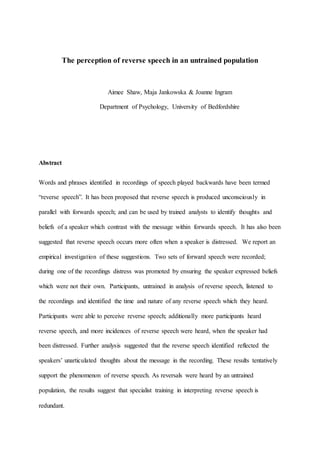The perception of reverse speech in an untrained population Abstract
•Download as DOCX, PDF•
1 like•100 views
Participants listened to recordings of forward speech where the speaker was either distressed or not distressed. More participants heard reverse speech from the recording where the speaker was distressed, and they identified more incidences of reverse speech overall from that recording. The reverse speech identified by participants seemed to reflect the speaker's unarticulated thoughts about the message in the recording. These results provide tentative support for the existence of reverse speech occurring unconsciously and more when a speaker is distressed.
Report
Share
Report
Share

Recommended
Recommended
More Related Content
What's hot
What's hot (7)
Unit 2 characteristics of pws and the abcs of stuttering

Unit 2 characteristics of pws and the abcs of stuttering
Similar to The perception of reverse speech in an untrained population Abstract
Similar to The perception of reverse speech in an untrained population Abstract (20)
Perception of Reverse Speech in an Untrained Audience Poster

Perception of Reverse Speech in an Untrained Audience Poster
IJCER (www.ijceronline.com) International Journal of computational Engineerin...

IJCER (www.ijceronline.com) International Journal of computational Engineerin...
Fluency disorder (Stuttering also known as stammering)

Fluency disorder (Stuttering also known as stammering)
Nonverbal Communication In A Police Interrogation Oldversion

Nonverbal Communication In A Police Interrogation Oldversion
Eduardo Coutinho - Psychoacoustic cues to emotion in speech prosody and music

Eduardo Coutinho - Psychoacoustic cues to emotion in speech prosody and music
The perception of reverse speech in an untrained population Abstract
- 1. The perception of reverse speech in an untrained population Aimee Shaw, Maja Jankowska & Joanne Ingram Department of Psychology, University of Bedfordshire Abstract Words and phrases identified in recordings of speech played backwards have been termed “reverse speech”. It has been proposed that reverse speech is produced unconsciously in parallel with forwards speech; and can be used by trained analysts to identify thoughts and beliefs of a speaker which contrast with the message within forwards speech. It has also been suggested that reverse speech occurs more often when a speaker is distressed. We report an empirical investigation of these suggestions. Two sets of forward speech were recorded; during one of the recordings distress was promoted by ensuring the speaker expressed beliefs which were not their own. Participants, untrained in analysis of reverse speech, listened to the recordings and identified the time and nature of any reverse speech which they heard. Participants were able to perceive reverse speech; additionally more participants heard reverse speech, and more incidences of reverse speech were heard, when the speaker had been distressed. Further analysis suggested that the reverse speech identified reflected the speakers’ unarticulated thoughts about the message in the recording. These results tentatively support the phenomenon of reverse speech. As reversals were heard by an untrained population, the results suggest that specialist training in interpreting reverse speech is redundant.